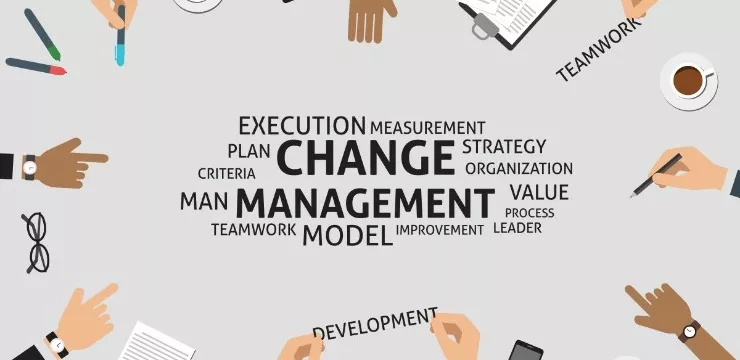
If you are looking for a quick introduction to change management, you’ve come to the right place.
Below, we’ll cover change management from a bird’s-eye perspective:
- How organizational change is managed
- What exactly change managers do
- Why it matters
- Which roles are involved
Among other topics.
Let’s start at the foundation:
An Introduction to Change Management: What It Is and How It Works
Change management is a business discipline devoted to managing, organizing, and executing organizational change initiatives.
An organizational change – such as hierarchical restructuring or the adoption of new technology – takes time, effort, and coordination.
This is where change management comes in.
Change managers do a great many things, such as:
- Analyze business problems and design solutions
- Create and execute change projects
- Communicate and coordinate with employees, executives, and other stakeholders
- Measure, analyze, and optimize change projects
These duties are accomplished through a human-centered approach to change.
That is, change managers effect organizational change by starting at the individual level.
Effective change is accomplished by:
- Building awareness of and interest in a particular change agenda
- Inspiring action
- Providing the tools necessary for change
- Offering training and approaches for building skills
Many change managers use a variety of tools and techniques to accomplish their objectives.
A few include:
- Change management frameworks or models
- Project management software, digital adoption platforms, training software, onboarding software, and other digital tools
- Data analysis and management tools
- Employee onboarding templates
Among many others.
The tools employed by any one change manager will naturally vary depending on the nature of their job and the change project.
Why Change Management Matters
We have seen what change managers do.
But what is in it for the company?
Why not simply mandate or execute change directly?
On the surface, directly executing change projects would seem to cost less.
It’s true that change management comes with overhead.
However, the ROI of change management dramatically outweigh its costs:
- Unmanaged change projects run into huge roadblocks. A few of these include employee resistance, unforeseen costs, communication barriers, skills deficits, and so on. Management is specifically designed to overcome such barriers to organizational change.
- Managed change increases project efficiency and effectiveness. Change managers are trained and experienced professionals – their job is to identify obstacles, mitigate risk, set targets, and create strategies for achieving success.
- Failure is more likely without change management. And a failed change project can set a company back significantly, both financially and in terms of morale. Failed projects undercut confidence in leadership, reduce motivation for future change projects, and breed further resistance.
In general, the more sophisticated the approach to change management, the higher the ROI.
Who Manages Change
There are a number of people involved in change management.
Typically, these can be divided into tiers based on their role within the existing business.
Change consultancy Prosci identifies five groups:
- The change management resource/team – This group applies structured change management approaches, strategies, and plans.
- Executives and senior managers – Executives build a coalition of sponsorship and communicate directly with employees.
- Managers and supervisors – Managers coach employees and advocate for change, while also managing resistance and facilitating communication.
- Project team – The project team designs and implements the actual change, and they ensure that the project stays in sync with the people side of change.
- Project support functions – Project support can include subject matter experts, trainers, business analysts, or other specialists.
Different change frameworks divide responsibilities differently.
However, they all follow a similar pattern.
Regardless of which specific change framework is employed, it is important to establish roles, delegate tasks, and assign responsibilities.
A Basic Example of Change Management
Here is a basic example of change management in action:
- A company identifies problems with its sales process. Obsolete software hinders sales efforts and suppresses results. As a result, competitors are outpacing them.
- Change managers work together with specialists to research solutions. They explore potential sales technology solutions. After sufficient research, they choose to begin their digital journey with a new CRM.
- Change management draws up a project roadmap. The stage-based change project includes hiring IT specialists, training in-house IT staff on the technology, and training the sales staff with digital adoption solutions.
- The change initiative is executed. The change process begins with two-way communication, a thorough onboarding process, and initial training. During rollout, staff are trained with a combination of webinars, blog articles, and digital adoption platform tutorials.
- Then the results are evaluated. After the project is finished, change managers collect feedback and review the project.
This pipeline is a simplified example that demonstrates how change projects work.
The larger the project – and the larger the organization – the more involved and complex the process.
Further Reading
For more information about change management, feel free to browse change management articles on this blog.
There are a number of posts devoted to change management topics, such as:
- The basics of change management
- Change management frameworks and models
- Change management and organizational development certifications
- Change leadership
- Change management exercises, tools, and tips
And much more.
WalkMe Team
WalkMe spearheaded the Digital Adoption Platform (DAP) for associations to use the maximum capacity of their advanced resources. Utilizing man-made consciousness, AI, and context-oriented direction, WalkMe adds a powerful UI layer to raise the computerized proficiency, everything being equal.



